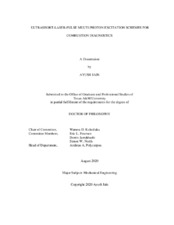| dc.description.abstract | Laser-based diagnostic approaches using ultra-short femtosecond (fs) laser pulses is a promising method for investigating complex chemically reacting flow fields such as flames. Femtosecond pulses offer several advantages over traditionally used nanosecond (ns) and picosecond (ps) pulses because of their broad spectral bandwidth, high peak power, and high repetition rates. They can be especially advantageous for efficient multi-photon excitation schemes. During the past decade, fs laser diagnostic has been developed and demonstrated primarily in gaseous flames and canonical geometries; however, their implementation for studying more practically relevant harsh combustion environments has been limited. Thus, the objective of this thesis research is to investigate methodologies to extend the applications of ultrashort, fs-pulse-based laser-induced fluorescence (LIF) techniques to imaging studies in realistic flame environments. This thesis consists of four main research tasks; (i) understanding the role of H-atoms in sooting formation by implementing ts two-photon LIF (fs-2pLIF) imaging, (ii) explore the applicability of fs imaging schemes in practically relevant hardware containing thick optical windows by using fs 3-photon LIF (fs-3pLIF) detection of H-atoms, (iii) extension of fs LIF methods for simultaneous multi-species detection using a single laser pulse by demonstrating H-atom and OH radicals imaging, and (iv) increasing imaging dimensionality by developing efficient, high-energy tunable laser source via direct frequency conversion.
Under the first task, the previously demonstrated H-atom 2pLIF scheme ( = 205 nm) in laminar methane/air flames was extended to the harsh environment of heavily sooting flames for the first time. The implementation of several signal interference mitigation strategies enabled analyzing the relevance of H-atom concentration on soot formation pathways at atmospheric pressure ethylene/air flames. The experiments were performed on a series of sooting flames ranging from lean ( = 0.8) to very rich ( = 3.0). These studies revealed an inverse dependence of soot volume fraction (fV) on the H-atom number density ([H]), and a strong dependence of [H] and fV on flame temperature.
In combustion test hardware such as optically accessible internal combustion (IC) engines and gas turbines test rigs, reactions take place at elevated pressures (10–50 bar) and hence involve test sections with thick optical windows. It has been realized that 205-nm deep UV (DUV) pulses can be problematic in cases with thick transmissive optics resulting in high absorption losses and other adverse nonlinear effects. Therefore, for detecting H atoms, red-shifting the excitation wavelength to 307-nm pulses and using 3pLIF excitation scheme can be beneficial in such situations. Under the second task, a detailed 2pLIF vs 3pLIF comparison was performed to characterize different levels of photolytic production, photoionization, and stimulated emission interferences. To the best of our knowledge, the H-atom 3pLIF scheme using = 307.7-nm photons was realized for the first time during this work.
The implementation of the above 3pLIF scheme also enabled the extension of this diagnostic approach for simultaneous imaging of multiple species using a single excitation laser pulse. Under the third task, simultaneous detection of H-atom (via 3pLIF) and OH (via single-photon LIF) was achieved using the excitation wavelength of λ = 307.7 nm. This simultaneous detection provides an insight for understanding the effects of light species transport and preferential diffusion of H by revealing their spatial location with respect to the reaction zone marked by the OH radicals. The simultaneous H/OH detection is also important in understanding complex flame phenomena such as local extinction and reignition in turbulent flames and as soot formation pathways.
In the last part of this thesis research, a more efficient wavelength generation scheme for acquiring high-energy tunable fs laser pulses was developed to generate high-energy UV pulsed for fs LIF imaging applications with increased dimensionality. The availability of high pulse energy is important for diagnosis in practical combustion systems to account for numerous transmission losses as well as increase the size of the field of view to discern turbulent structures. The high-efficiency third-harmonic generation (THG) scheme was implemented to generate tunable UV pulses near = 283 nm. The THG scheme was implemented for high-fidelity single-laser-shot planer LIF (PLIF) imaging of OH at 1-kHz data rate to study the flame structure and reaction zone in turbulent non-premixed flames using a high-speed imaging system.
The above developments and the associated results discussed in this thesis is a significant step forward in implementing ultrashort pulse laser imaging techniques of intermediate chemical species for practically relevant combustion studies. | en |


